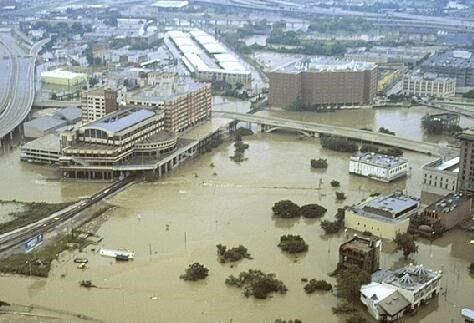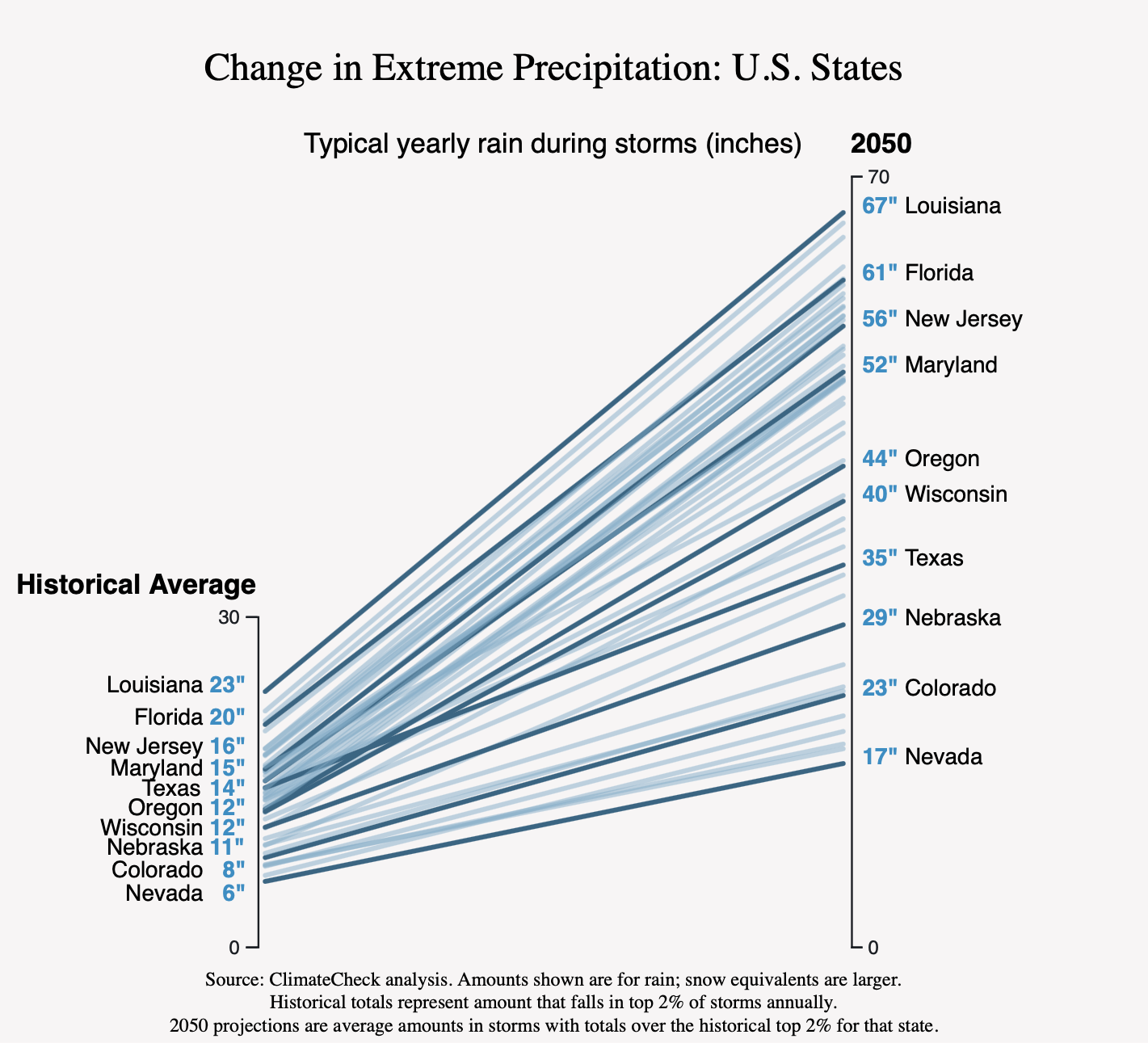What is Flooding?
Flooding is the overflowing of water onto dry land. Floods can happen as a result of heavy rains, ocean storms, rising sea levels, snow melt, or breaks in dams or levees. Of all the weather-related natural disasters that occur, floods are the most common. Even a few inches of water can cause significant damage to property, but many flooding events involve deep, fast-moving water. Flash floods can last just minutes, while other types of flooding can persist for weeks. As a result of the effects of climate change, flooding is increasing in frequency and severity across the United States.

Types of Flooding
There are many different causes of flooding. Here is a look at some of the most common.
- Sea Level Rise:
Sea levels are rising globally, increasing the risk and frequency of coastal flooding, primarily as a result of land and sea ice melting due to increased global temperatures. Thermal expansion of warming oceans is another significant factor. NASA currently estimates seas are rising at a rate of 3.3 centimeters per year, caused primarily by climate change induced by increasing greenhouse gases. In certain locations, other factors such as subsiding land, erosion and tidal changes can also be factors.

- Storm Surge:
Storm surges occur when strong storms cause sea levels to temporarily rise, resulting in coastal flooding. Storm surges are caused either by strong winds pushing water on-shore, or when low air pressure allows the water to rise near the shore, or both. They can also be aggravated by heavy rains that accompany storms and hurricanes, as well as by rising sea levels. - River flooding / Fluvial Flooding:
River flooding, also known as fluvial flooding, is when water in a river or stream rises and pours over onto the surrounding land, causing a flood. These types of floods can be devastating to people who live in river flood zones. - Surface flooding / Pluvial Flooding:
Surface flooding, also known as pluvial flooding, is when high levels of precipitation exceed the ability of natural and man-made drainage systems to drain the water fast enough. The resulting water buildup leads to flooding. Human ground-covering infrastructure such as parking lots, roads, and other concrete areas can decrease the ability of the ground to absorb and drain water. Pluvial flooding tends to be more localized than fluvial (river) flooding which can affect large areas around major rivers. - Dams / Levees Bursting:
Burst dams and levees can happen because of infrastructure failure due to lack of maintenance or poor construction. It can also be a result of the compounding effects of other extreme weather events causing stress on dam and levee infrastructure. This was the case with Hurricane Katrina in 2005, where turbulent waters burst a levee in New Orleans. This resulted in a flood that left 80 percent of the city of New Orleans under water and resulted in over 1,800 deaths.
What are the Effects of Floods?
Floods are the most common disaster in the United States and therefore have a powerful economic and personal impact. The consequences of flooding can vary widely depending on the type, location, duration, depth and speed. It is also important to consider the vulnerability, value, and population of the affected area. In natural systems, floods serve the beneficial purpose of maintaining key ecosystem functions and biodiversity. All but the most extreme floods serve the natural purpose of altering river beds, rejuvenating wetland habitats, and triggering breeding events, migration, and dispersal. Yet, when floods encounter human infrastructure they can cause direct and harmful impacts.
Every year in America, floods cause massive damage to homes and infrastructure. In 2019, floods were responsible for over $3.75 billion worth of property and crop damage in the United States. This destruction can stem from the strong force of the water, the impact of debris carried within the water, or lingering effects of water exposure. Possessions within flooded houses can be submerged and carried away and water can lead to structural problems and mold growth.
The immediate damage of a flood to the property, land, and infrastructure of a city can be disastrous. But the damage done by ongoing flood conditions can cause a variety of equally challenging secondary effects. Flood conditions can cause waterborne illnesses, disruption in communication services, economic standstill, and dislocation of people. In the long term, these effects can leave communities deeply impacted and economically vulnerable for years to come.
The severity of local damage varies widely by location. Many population centers are at very low risk of experiencing floods because they are not within immediate proximity of large bodies of water or subject to extreme rainfall. However, most areas of the U.S., even dry and mountainous regions, are susceptible to some type of flooding. Other towns are more prone to the risks of flooding and therefore more likely to be subject to both mild and extreme effects of flooding. Individual home damage resulting from flooding can also vary widely. The amount of damage depends on the vulnerability of the property and the proximity of the home to the most heavily impacted areas.
How is Climate Change Increasing Flooding?
Climate change is creating conditions that are worsening the frequency and severity of flooding. Storms are getting more severe on average as global temperatures rise, causing more frequent flooding. Storms are also creating more moisture than previously which increases flood risk. In fact, storms now generate 27 percent more moisture than they did 100 years ago.

Apart from dramatic storms, rising global temperatures are leading to more evaporation from rivers and oceans and changes in streamflow and snowmelt conditions. Each of these changes can cause river flooding to dramatically decrease in some locations and increase in others. Instability and uncertainty of flood patterns and risk due to climate change is likely to be an increasingly significant issue.
What Areas are the Most Affected by Flood Risks?
People who live in recognized flood zones are at the most risk of having their properties damaged by floods. Flood zones are geographic areas which have been designated by FEMA for having a high risk of floods. Most flood zones are land that is near bodies of water such as rivers, lakes, ponds, streams, or oceans, or in areas that get a large amount of rainfall each year.
To help understand rapidly changing flood risks, FEMA publishes flood maps that can give information about local flood risks.
In addition to flood zones, your home can have a higher risk of being damaged by a flood if it is in one of the states most vulnerable to flooding.
The top ten states with the most floods are:
1. Florida
2. Louisiana
3. California
4. New York
5. New Jersey
6. Virginia
10. Georgia
Cities with high flood risk include:
- Bonita Springs, FL
- Cape Coral, FL
- Miami, FL
- Myrtle Beach, SC
- Savannah, GA
- Sarasota, FL
- New Orleans, LA
- Charleston, SC
- Houston, TX
- Brownsville, TX
Flood Risk Adaptation Options for Homeowners
Anyone who is considering buying a home should carefully weigh the risks of investing in a flood-prone area. The ClimateCheck property report and FEMA flood maps are powerful tools to help assess specific flood risk for properties you are considering purchasing. For those already invested, here are a variety of adaptation options:
Purchase appropriate flood insurance.
- Look into options with your insurance provider, protecting from flood damage will likely involve purchasing a flood insurance policy in addition to basic home insurance
Upgrade your home to increase resistance to flood events.
- Construct walls and other landscaping barriers to protect your property from the brunt of flooding activity, especially for coastal properties. Sandbag walls are great temporary barriers
- Seal basement walls and floors to prevent water seepage
- Consider elevating your home on pillars or other water resistant supports
Conclusion
Floods are widespread, frequent, and can be highly destructive. Due to climate change, it is likely that they will only get more severe over time. Cities and towns that are on the coast and that are close to sea level are at especially severe risk for floods. If you are concerned about your property being damaged by floods, then you should take what steps you can to mitigate risks. Your best protection, however, is to avoid purchasing in a flood-prone area.
If you currently own a property or are looking at purchasing, you can assess your risks with the ClimateCheck property report.
Read More About Flood Risks
- Mitigating Flood Risks to Your Home
- How to Read FEMA Flood Zone Maps
- What are the FEMA Flood Zone Designations - A-X
- Can You Change Your FEMA Flood Zone Designation?
- Sea Level Rise Risks for Real Estate Properties
- Coastal Flooding, Subsidence and Absolute vs Relative Sea Level Rise
- What is Storm Surge?
- Rising Ocean Temperatures and Climate Change